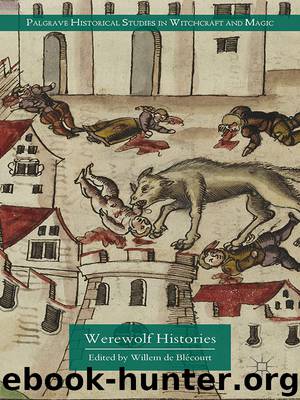Werewolf Histories by Willem de Blécourt

Author:Willem de Blécourt
Language: eng
Format: epub
ISBN: 9781137526359
Publisher: Palgrave Macmillan
Published: 2015-03-14T16:00:00+00:00
6
‘Species’, ‘Phantasia’, ‘Raison’: Werewolves and Shape-Shifters in Demonological Literature
Johannes Dillinger
This chapter discusses various concepts of animal transformation in the demonological literature of the late Middle Ages and the early modern period. It focuses on five most prolific advocates of witch-hunting: Heinrich Kramer, inquisitor and author of the Malleus maleficarum; Jean Bodin, celebrated jurist, intellectual founding father of the modern state and ardent propagandist of witch hunting; Nicholas Rémy, a career administrator de facto in charge of law enforcement in the duchy of Lorraine for several years; Martin Delrio, a theologian and jurist who wrote an almost encyclopaedic treatise on magic; and Pierre de Lancre, a judge with extensive experience with concrete witch trials and a marked interest in werewolfery.1 Other authors will only briefly be dealt with. As this chapter concentrates on authors who contributed to the witchcraft doctrine the medicinal debate about lycanthropy as a mental condition is largely left out.2 Firstly, the text will briefly sketch the conditions of the debate on the werewolf: It will review fundamental theological statements concerning animal transformation and early demonological writings provoked by the nascent witch-hunts of early fifteenth-century Switzerland. After that, the chapter will deal with each demonologist in turn in chronological order, giving the main arguments of each and exploring the interrelations between authors. The chapter focuses narrowly on animal transformation, especially werewolves, but tries to integrate the discussion of shape-shifting in the wider context of concepts of reality and plausibility in the witchcraft doctrine.
Early demonologists
Demonologists always had to face the fact that the canonical law and the confessional literature of the Middle Ages were comparatively critical about the belief in magic. The Canon Episcopi, which condemned the belief in magical flight, is well known in witchcraft research. A rather neglected passage of the Canon explicitly anathematised belief in transformation: ‘Whoever believes that it might happen that any agency other than that of the Creator who created everything transforms any creature to its advantage or disadvantage or changes it into another form (species) or into another image is certainly an infidel and worse than a heathen’.3 This would clearly suggest that demons, let alone magicians, could not transform human beings into animals. The essential form (‘species’) of all creatures was determined by the will of the Creator and thus unchangeable. It would seem that all adherents of the witchcraft doctrine who defended the existence of werewolves would have to fight an uphill battle against this piece of canon law. But matters were even worse for them. Burchard of Worms, also well-known for his rejection of the nightly flight of magicians, addressed shape-shifting in an equally uncompromising way: It is forbidden ‘to believe that women whom the common folk call the Fates (Parcae) exist or possess the powers that are attributed to them: At the birth of a man, they destine him to whatever end they please, even in such a way that this man is capable of transforming into a wolf at will – this the common stupidity calls the werewolf – or into any other form’.
Download
This site does not store any files on its server. We only index and link to content provided by other sites. Please contact the content providers to delete copyright contents if any and email us, we'll remove relevant links or contents immediately.
Cecilia; Or, Memoirs of an Heiress — Volume 1 by Fanny Burney(32434)
Cecilia; Or, Memoirs of an Heiress — Volume 2 by Fanny Burney(31871)
Cecilia; Or, Memoirs of an Heiress — Volume 3 by Fanny Burney(31852)
The Great Music City by Andrea Baker(31348)
We're Going to Need More Wine by Gabrielle Union(18967)
All the Missing Girls by Megan Miranda(15568)
Pimp by Iceberg Slim(14393)
Bombshells: Glamour Girls of a Lifetime by Sullivan Steve(13972)
Talking to Strangers by Malcolm Gladwell(13222)
Norse Mythology by Gaiman Neil(13204)
Fifty Shades Freed by E L James(13157)
For the Love of Europe by Rick Steves(12977)
Mindhunter: Inside the FBI's Elite Serial Crime Unit by John E. Douglas & Mark Olshaker(9200)
Crazy Rich Asians by Kevin Kwan(9167)
The Lost Art of Listening by Michael P. Nichols(7406)
Enlightenment Now: The Case for Reason, Science, Humanism, and Progress by Steven Pinker(7228)
The Four Agreements by Don Miguel Ruiz(6630)
Bad Blood by John Carreyrou(6552)
Weapons of Math Destruction by Cathy O'Neil(6143)
